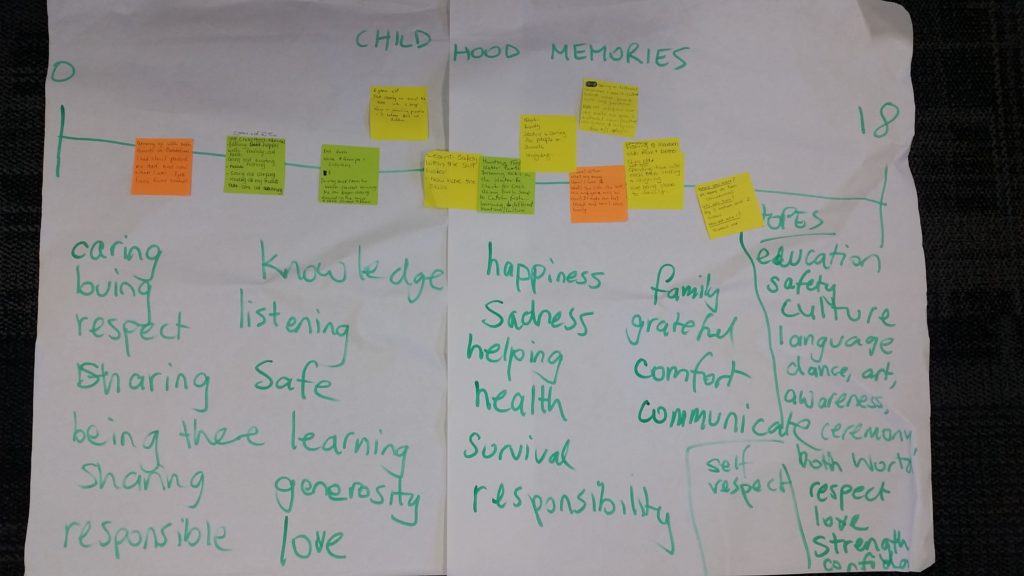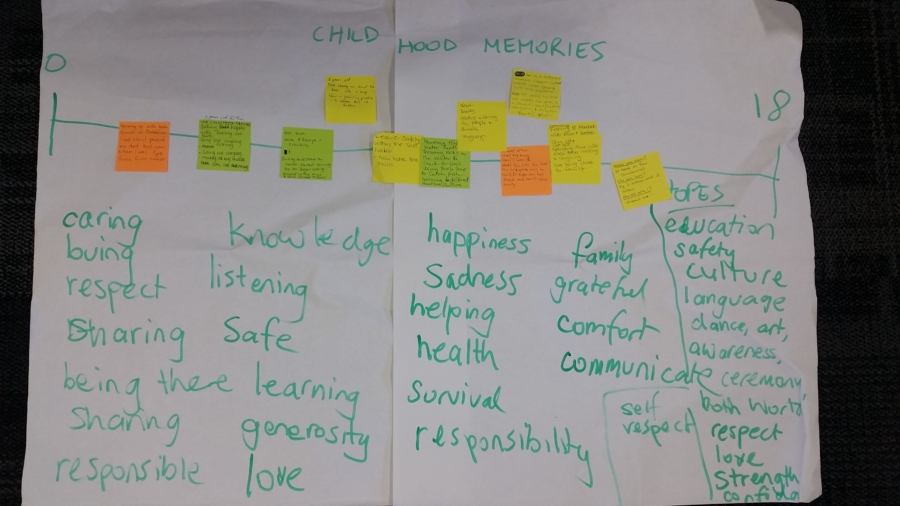
A HOC Learning Workshop for strong Aboriginal Women in community
Since the Healing Our Children (HOC) project began, I have been responsible for developing Learning Workshops (aka a training program) for Aboriginal women in remote communities. I was particularly interested in finding ways of engaging workshop participants that fits with a two way learning approach. The methodology of Collective Narrative Timelines sat very comfortably with me because it powerfully honours the knowledge of everyone in the room. Cheryl White has said “this was a method that enabled participants to share powerful personal memory and history but in a way that linked to a collective theme. It brought people together while also acknowledging a great diversity of experience.” (Denborough 2008, p. 144)
The process generally goes like this.
Draw a timeline on a long piece of paper that stretches across a large wall.
Draw a map of the world.
Ask the group to reflect on a wish, a commitment, a hope, a learning or a value that is important to them. Ask each person to think about:
- the history of this wish/commitment/hope/learning or value and when it began. What year/date?
- Where did you learn this or develop this (what place)?
- Who did you learn it from?
- Who did you learn it with? (Denborough 2008, p. 147)
Each person is given a small piece of paper to document this story in a few sentences. They are then invited to stick their piece of paper on the timeline at the appropriate date/year and briefly share their story with the group. If the person has a link to a particular place, this can also be marked by a dot on the map with a few words depicting their story.
The focus of my Learning Workshops is on the theoretical and cultural knowledge underpinning understandings of how trauma occurs in early childhood. I wanted my Narrative Timeline activity to orient the women participants to this topic by moving them into a place of looking through children’s eyes, by reflecting on their own childhood experience. This was a bit of a twist on the original Narrative Timeline approach in that it is also quite therapeutic. The following was indicative of the instructions I gave to set this up.
“We’re going to take a moment to think about what it was like for us to be a child and to document some of these memories on a timeline. For some of you it might be uncomfortable to think about a childhood memory, so if this becomes too hard for you, it’s OK to have some time out. See if you can think of a particular time when your parents said something to you or did something, that really had an impact on you. This can be a good or not so good memory but you might find it more pleasant to think about a positive memory you have. It needs to be a memory you are comfortable sharing with the group. Try to remember:
- Where you were?
- Who was there?
- How old you were?
- What was said or done?

A collective narrative timeline of Aboriginal women’s childhood experiences
The timeline that I had drawn up was a Child Age Timeline from 0 – 18 years. Each participant was invited to stick their paper on the timeline on the age that related to their story and briefly share their reflection. I also followed up with the question ‘How has this memory shaped the person that you are today in a positive way (emphasizing that both good memories and bad memories can shape us in positive ways)? This question got the women thinking about how their own childhood experience influenced their current parenting with their own children or grandchildren. To illustrate this point, I would also share my own childhood memory on the timeline – receiving painful physical discipline with a strap – and how this shaped my own parenting beliefs and a commitment to never use harsh physical discipline on my own children.
As a follow up to this activity, we also reflected as a group on:
- For those of you that had a good memory….What was it that you really appreciated about your parents?
- For those that had a bad memory…Is there something you would have liked your parents to do or say instead? What would you have liked more of?
Then everyone was invited to reflect on…
- What does this say about any hopes you have or had for your children?
These key messages were written under the timeline, as future commitments or as a way of reconnecting with closely held past commitments.
The light bulb moments are usually the connections people make when they reflect on a significant childhood memory and the particular skills, knowledge and values they have taken on from their parents/grandparents and how this has shaped them today. Simple realisations like:
- a commitment to ‘taking responsibility’ from the experience of being blamed by a mother for everything as a child
- the importance of ‘having a joke and seeing the lighter side of life in times of crisis’ related to the carefree attitude of a grandfather who laughed off a near miss car accident
- ‘being open to different religious points of view’ because grandma went to lots of different churches and cultural events
- ‘the importance of family above all else’ being raised by a mother who showed so much love.
These realisations although personal for each individual also have resonance with the whole group. Although diverse, the combined wisdom of Elders, strong women and struggling grand/parents is honoured. It is through our collective experience of early childhood experience and its influence on us as parents or carers, we are connected and united. This visual representation of collective history we created together stayed on the wall during the remainder of our workshop. It is from this shared standing point that we progressed into the meatier, heavier topics of trauma and its impact on children in our LearningWorkshop.
References:
Denborough, D. 2008, Collective Narrative Practice: Responding to Individuals, Groups and Communities who have experienced Trauma, Dulwich Centre Publications.
For more ideas on working with Aboriginal women around parenting using reflections from their own childhood experience, see Rings of Growth.

